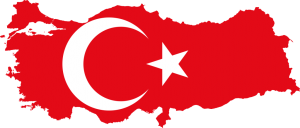By Sarah-Claire Jordan
 The Republic of Turkey is a country full of history, architecture, flavors, and culture. Once the center of the great Ottoman Empire, and inhabited for centuries before that, the extent of cultural exchange that occurred, and still occurs, in Turkey is astounding. Its strategic location straddling Asia and Europe made it an extremely important point along many trade routes, most notably the Silk Road. This means that merchants from all over Asia and Europe were constantly passing through, with many ending up settling there.
The Republic of Turkey is a country full of history, architecture, flavors, and culture. Once the center of the great Ottoman Empire, and inhabited for centuries before that, the extent of cultural exchange that occurred, and still occurs, in Turkey is astounding. Its strategic location straddling Asia and Europe made it an extremely important point along many trade routes, most notably the Silk Road. This means that merchants from all over Asia and Europe were constantly passing through, with many ending up settling there.
In terms of the languages spoken in Turkey, centuries of contact with so many other cultures have made their mark on Turkish demography. There are over 30 different languages spoken in Turkey, but a handful are spoken by more people than others. Here are the four most common languages:
1. Turkish
Though there are other languages in the Turkic language family, Turkish is the most widely spoken of all of them. There are over 60 million native speakers of Turkish, with some speakers living in neighboring countries or even further away. Turkish has a few unique characteristics, like its vowel harmony and the strong presence of agglutination, which is when pieces of words can be strung together to form new words. There are also no noun classes or grammatical gender in Turkish.
2. Kurmanji
Also known as Northern Kurdish, Kurmanji refers to a group of Kurdish dialects spoken in parts of Syria, Iran, Iraq, and Turkey. It is the most common of the Kurdish dialect groups, and is the ceremonial language of Yazidism, an ancient religion. About 80% of Kurds, an ethnic group from the Middle East, speak Kurmanji. It uses the Latin script, and the oldest book written in one of the dialects dates back to the 1500s. There are about five main dialects in the Kurmanji dialect group: Northwestern Kurmanji, Southwestern Kurmanji, Northern Kurmanji (also called Serhed), Southern Kurmanji, and Anatolian Kurmanji, which is also called Badînî.
3. Arabic
Possibly the most widely-spoken language in the Middle East, it makes sense that a portion of the Turkish population would speak Arabic, especially considering how close it is to predominantly Arab countries. The specific dialect native to southeastern Turkey is called North Mesopotamian Arabic and is also spoken in parts of Iran and Iraq as well as northern Syria and Cyprus. At one point in time, North Mesopotamian Arabic was spoken throughout all of Mesopotamia, but now it is only spoken in some areas, one of which is southeastern Turkey.
4. Zazaki
Zazaki is the language of the Zaza ethnic group native to what we now call Turkey. Their language belongs to the Indo-Iranian branch of the Indo-European language family, and shares many similarities with Gorani, a dialect group consisting of Northwestern Iranian dialects spoken by many Kurdish people. Zazaki is also similar to many of the Caspian languages, which are spoken by different groups living along the Caspian Sea. The number of speakers of Zazaki is somewhere between 1.5 and 4 million, which includes all of the dialects. There are three main dialects of Zazaki, with about ten subdialects.
In times like these, it is important for interpreters and translators to do what they can to help refugees and the countries receiving them. This is why Alpha Omega Translations works so hard to help its nonprofit clients who are on the frontlines trying to get help to as many people as possible.



